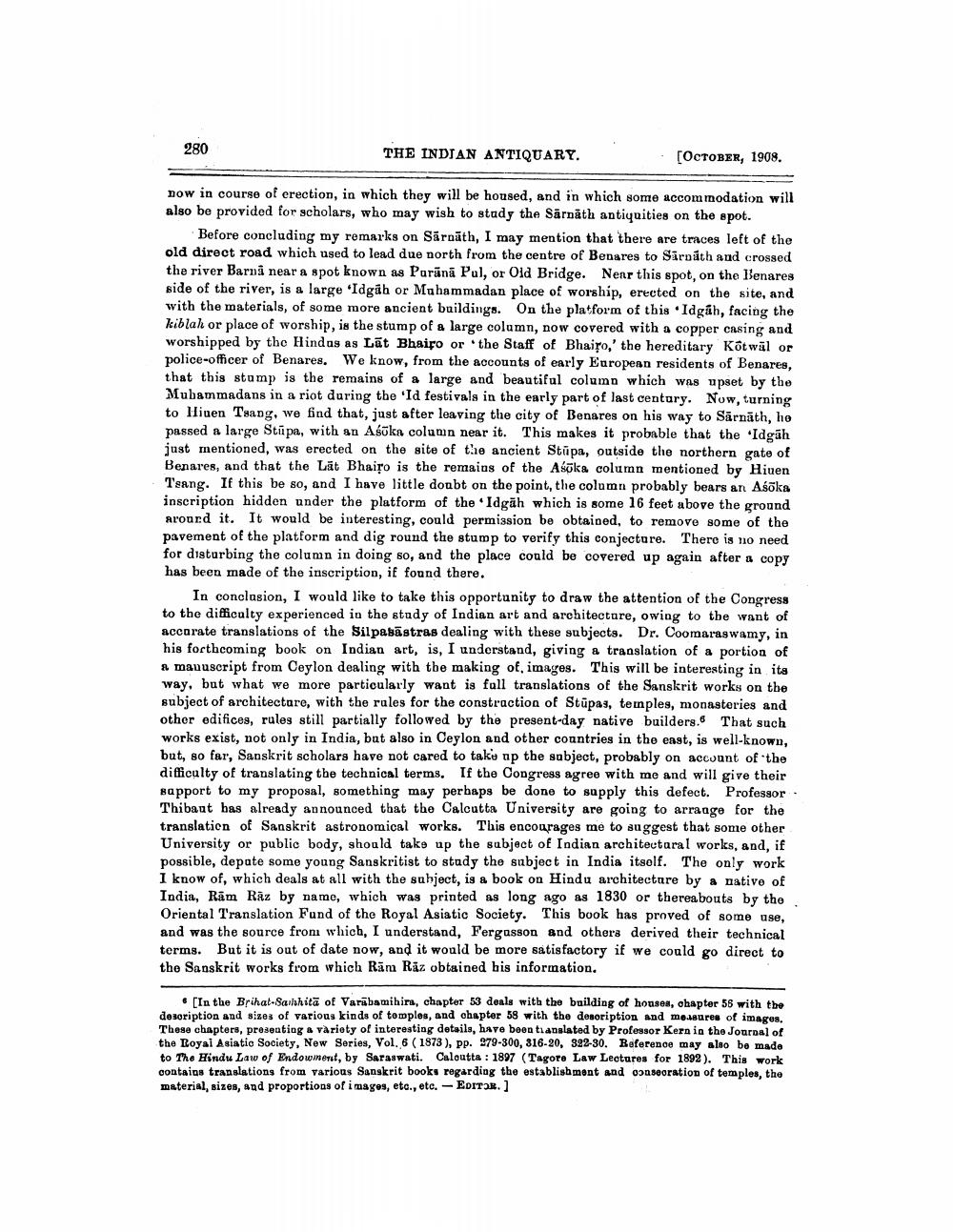________________
280
THE INDIAN ANTIQUARY.
. [OCTOBER, 1908.
now in course of erection, in which they will be housed, and in which some accommodation will also be provided for scholars, who may wish to study the Sārnath antiquities on the spot.
Before concluding my remarks on Sārgāth, I may mention that there are traces left of the old direct road which used to lead due north from the centre of Benares to Särnáth and crossed the river Barni near a apot known as Paraná Pal, or Old Bridge. Nenr this spot, on the Benares side of the river, is a large 'Idgah or Mohammadan place of worship, erected on the site, and with the materials, of some more ancient buildings. On the platform of this Idgáh, facing the kiblah or place of worship, is the stump of a large column, now covered with a copper casing and worshipped by the Hindus as Lāt Bhaipo or the staff of Bhairo,' the hereditary Kotwal or police officer of Benares. We know, from the accounts of early European residents of Benares, that this stamp is the remains of a large and beautiful column which was upset by the Mubammadans in a riot during the 'Id festivals in the early part of last century. Now, turning to Hiuen Tsang, we find that, just after leaving the city of Benares on his way to Särnāth, ho passed a large Stūpa, with an Asoka column near it. This makes it probable that the 'Idgāh just mentioned, was erected on the site of the ancient Stūpa, outside the northern gate of Benares, and that the Lat Bhairo is the remains of the Asöka column mentioned by Hiuen Teang. If this be so, and I have little doubt on the point, the column probably bears an Asöka inscription hidden under the platform of the Idgāh which is some 16 feet above the ground arourd it. It would be interesting, could permission be obtained, to remove some of the pavement of the platform and dig round the stump to verify this conjecture. There is no need for disturbing the column in doing so, and the place could be covered up again after a copy has been made of the inscription, if found there.
In conclusion, I would like to take this opportunity to draw the attention of the Congress to the difficulty experienced in the study of Indian art and architecture, owing to the want of accorate translations of the Silpasāstras dealing with these subjects. Dr. Coomaraswamy, in his forthcoming book on Indian art, is, I understand, giving a translation of a portion of s manuscript from Ceylon dealing with the making of images. This will be interesting in its way, but what we more particularly want is fall translations of the Sanskrit works on the subject of architectare, with the rules for the constraction of Stupas, temples, monasteries and other edifices, rules still partially followed by the present-day native builders. That such works exist, not only in India, but also in Ceylon and other countries in the east, is well-known, but, so far, Sanskrit scholars have not cared to take up the subject, probably on account of the difficulty of translating the technical terms. If the Congress agree with me and will give their sapport to my proposal, something may perhaps be done to supply this defect. Professor Thibaut has already announced that the Calcutta University are going to arraage for the translation of Sanskrit astronomical works. This encourages me to suggest that some other University or public body, should take up the subject of Indian architectural works, and, if possible, depate some young Sanskritist to study the subject in India itself. The only work I know of, which deals at all with the subject, is a book on Hindu architecture by a native of India, Rām Rāz by name, which was printed as long ago as 1830 or thereabouts by the Oriental Translation Fund of the Royal Asiatic Society. This book has proved of some use, and was the source from which, I understand, Fergasson and others derived their technical terms. But it is out of date now, and it would be more satisfactory if we could go direct to the Sanskrit works from which Rām Riz obtained his information.
. In the Brihat-Sanhita of Varūbamihira, chapter 53 deals with the building of houses, chapter 56 with the desoription and sizes of various kinds of tomples, and chapter 58 with the desoription and mesures of images. Those chapters, presenting a variety of interesting details, have been translated by Professor Kern in the Journal of the Royal Asiatic Society, New Series, Vol. 6 (1873), pp. 279-300, 316-20, 322-30. Reference may also be made to The Hindu Law of Endowment, by Saraswati. Caloutta : 1897 (Tagore Law Lectures for 1892). This work contains translations from various Sanskrit books regarding the establishment and consecration of temples, the material, sizes, and proportions of images, etc., etc. -EDITƏR]




